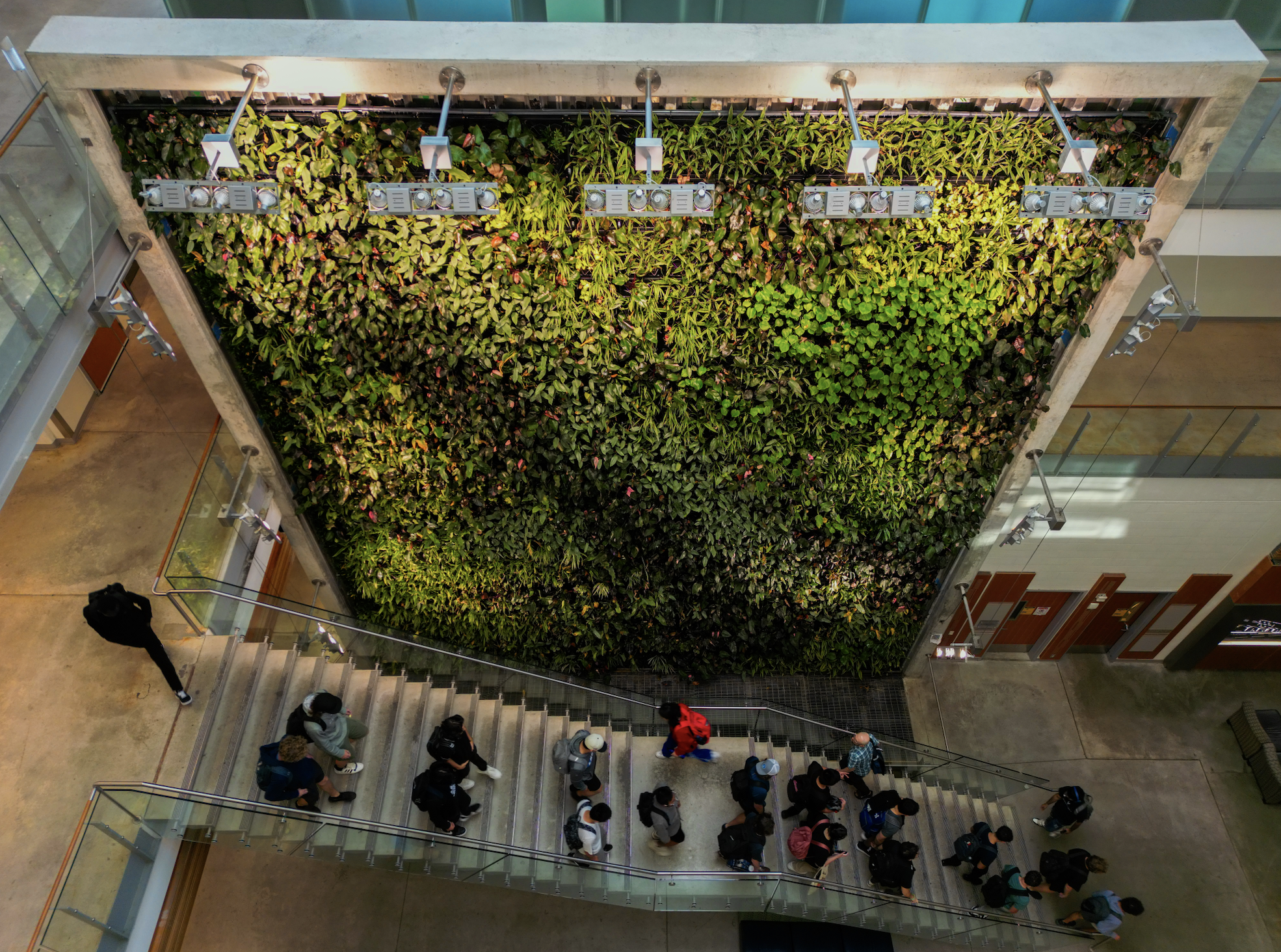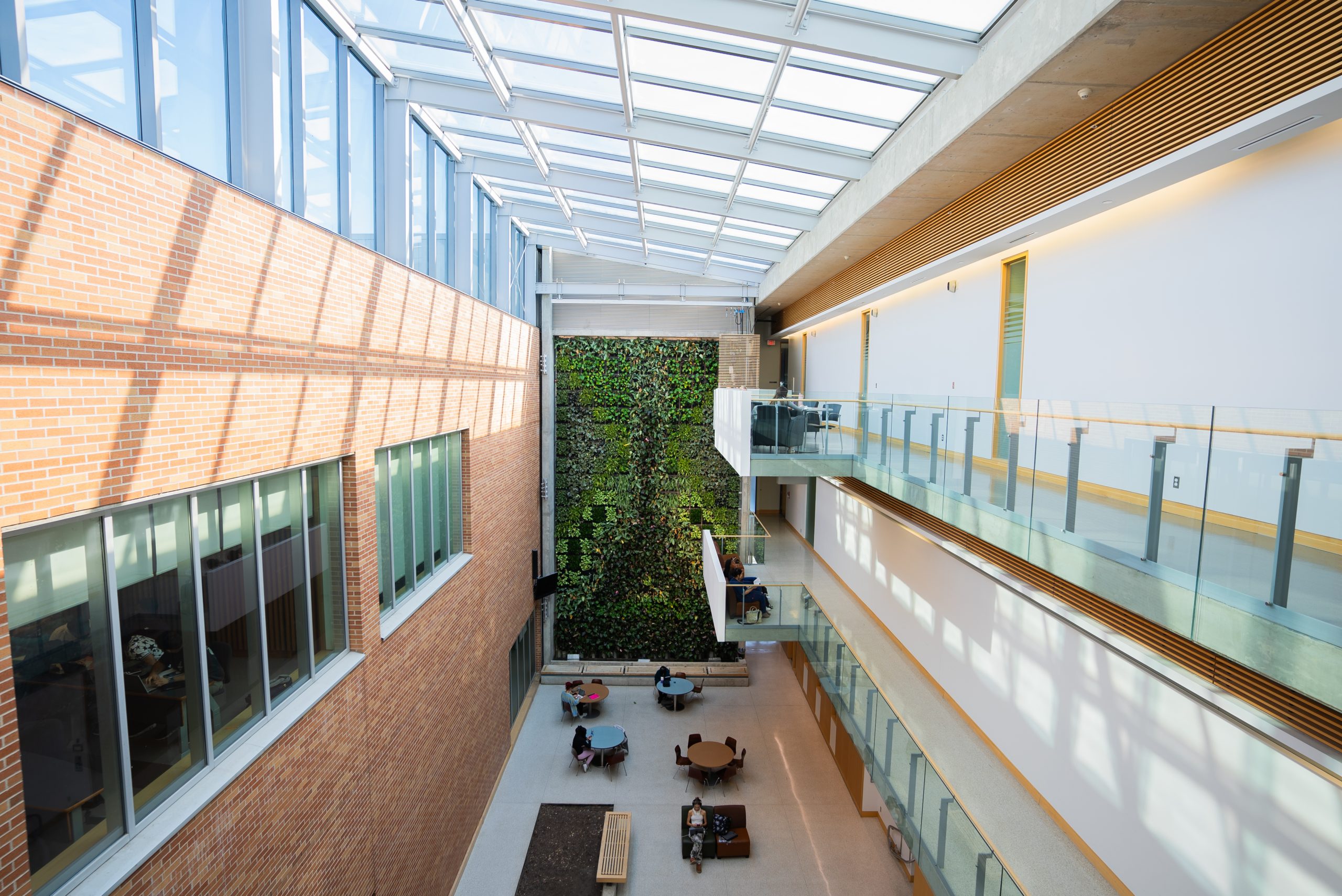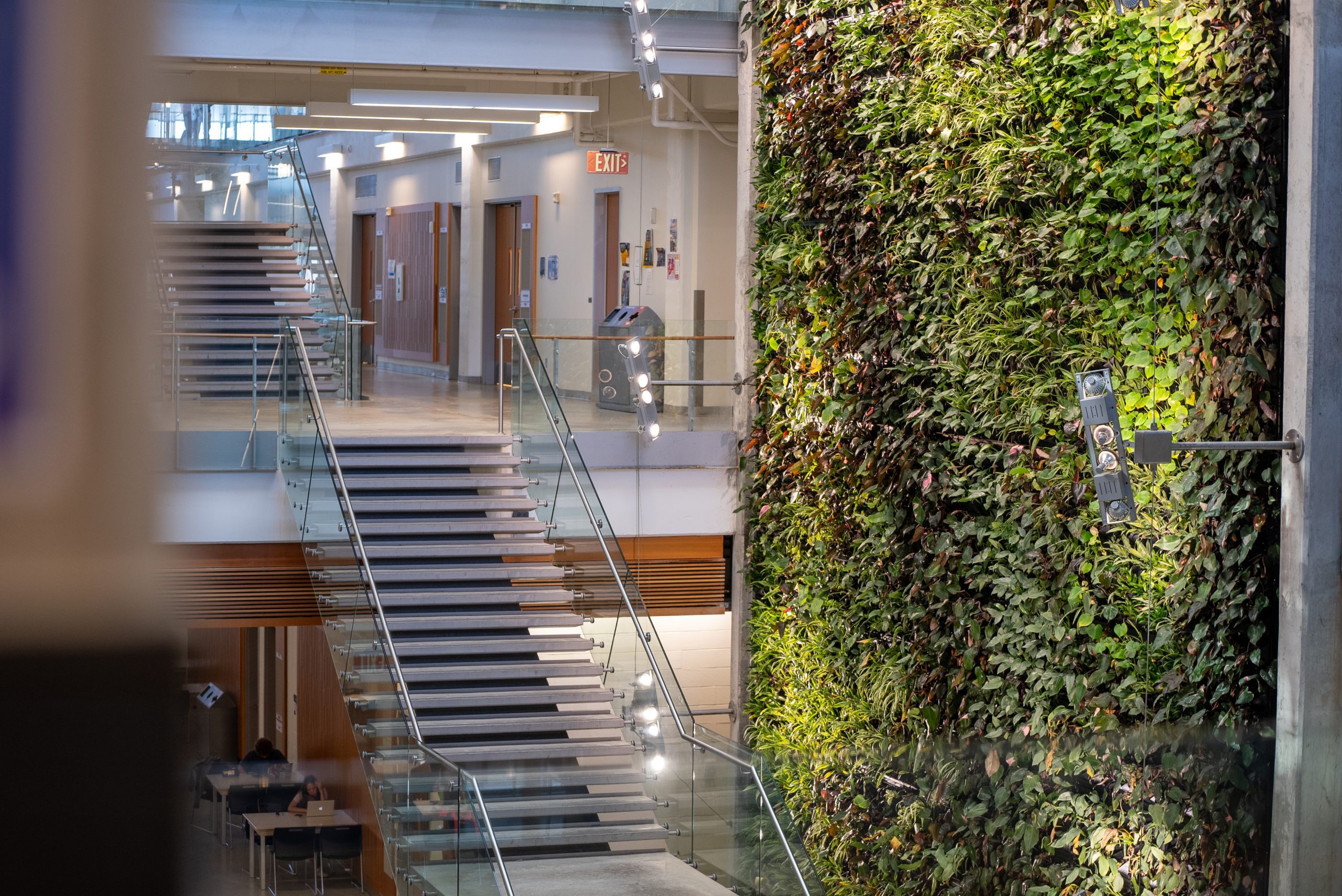In 2023, the University of Windsor – a pioneering educational institution committed to environmental sustainability – embarked on an ambitious journey towards becoming a carbon-neutral campus by the year 2050. In alignment with its Campus Carbon Neutral Master Plan, the university has recently implemented groundbreaking technology to significantly reduce its carbon footprint and promote energy efficiency.
One of the first steps in this endeavour was the restoration of two massive living walls, within the Medical and Engineering buildings on campus, that had reached the end of their life cycles. The refurbishment of the living walls included upgrades to integration with the Heating, Ventilation, and Air Conditioning (HVAC) systems, allowing them to function as biofilter living walls and improve indoor air quality on campus. By employing the most advanced biofilter living wall technology available, this project is set to provide the University of Windsor with naturally purified air indoors, lower ventilation requirements, and decreased operating costs.
Within the case study, we will dive deeper into the restoration project of the biofilter living walls, discuss how it supports the University of Windsor’s Campus Carbon Neutral Master Plan, and highlight the broader benefits that this project has for staff and students alike.

BACKGROUND
The University of Windsor, located in Windsor, Ontario, has been actively engaged in promoting sustainability initiatives and has shown a commitment to reducing its environmental impact and fostering a more eco-conscious campus. The Campus Carbon Neutral Master Plan reflects the institution’s dedication to mitigating its carbon footprint through a combination of energy efficiency measures, renewable energy sources, and offsetting strategies. This comprehensive plan encompasses various aspects of campus life, including energy consumption, transportation, waste management, and overall resource usage. By adopting renewable energy sources, implementing energy-efficient technologies, and promoting sustainable practices, the university aims to not only reduce its greenhouse gas emissions but also serve as a model for other educational institutions striving to create environmentally responsible campuses.
In 2023, they focused on additions and upgrades to the campus’ ventilation systems. First, with the installation of the dual drive, electric-steam turbine chiller which impacts more than 29 buildings across campus and is the first of its kind at a Canadian University. Following that was the restoration of two major biofilter living walls on campus. The implementation of this cutting-edge technology is anticipated to yield substantial benefits, with an annual reduction of approximately 8,300 tonnes of carbon dioxide (CO2) emissions – equivalent to removing 2,000 cars from the road. Furthermore, the university is poised to realize an annual cost saving of $1 million, allowing for increased investment in student-centric initiatives, scholarships, and bursaries.
CHALLENGES
As it pertains to the refurbishment of the living walls, the existing infrastructure had become outdated on two of the major living walls on campus. This prompted the need for a comprehensive assessment and redesign. New Earth Solutions was tasked with the mission of removing the previous living walls, a process that required meticulous planning and execution. The tear-down process involved removing thousands of plants, power washing the eroding structure, and eliminating debris and build-up from the previous system. This phase of the project took one week per living wall, a testament to the intricacy of the task.
OBJECTIVES
- Rebuild and replant the living wall to restore its aesthetic benefits.
- Upgrade the system to align with sustainability goals.
TERMINOLOGY
BIOFILTER LIVING WALLS
A biofilter living wall is a vertical structure covered with living plants that are used to improve indoor air quality. Although many people would like to believe that plants clean the air on their own, research conducted by Toronto Metropolitan University, the University of Guelph and now the National Research Council of Canada indicates that it’s the root zone of the plants and a build-up of beneficial microbes that break down and permanently destroy airborne pollutants. This process is known as biofiltration.
Biofilter living walls are designed to incorporate a variety of plant species, creating a visually appealing and sustainable solution for both aesthetic and functional purposes. These living walls are commonly implemented in urban environments, offices, residential buildings, and other spaces where occupant health and well-being are of utmost importance.
ASHRAE STANDARDS
ASHRAE Standard 62.1 is the recognized standard for ventilation system design and acceptable indoor air quality. Expanded and revised in 2022, this standard specifies minimum ventilation rates and other measures in order to minimize adverse health effects for occupants.
SOLUTION
PATH TO NET ZERO – RESPIRA BIOFILTER LIVING WALL
Biofilter living walls represent a leap forward in the world of vertical gardens when compared to traditional, passive living wall systems. While traditional living walls offer aesthetic benefits by adorning buildings with greenery, biofilter living walls take it a step further by actively improving indoor air quality. Through Improved technology and actively circulating air throughout the system, the biofilter living wall becomes an integral part of a building’s health. The Respira biofilter, installed by New Earth Solutions, emerged as a game-changer for the University of Windsor.
Placed in both the Centre for Engineering Innovation (CEI) and the Medical building, these walls will naturally purify a combined 20,000 CFM (Cubic Feet per Minute) of air, significantly improving indoor air quality.
By installing the Respira biofilter into campus buildings and integrating them into the HVAC systems, these living walls now add to the aesthetic appeal of the building while also contributing to the university’s Campus Carbon Neutral plans by creating fresh air indoors. This allows the building to reduce the amount of ventilation required to meet ASHRAE standards.


IMPLEMENTATION
A staggering 600 Respira modules were used between the two living wall projects, with each vertical column being interconnected to allow for both water and airflow. At the back of each module is an air plenum with cutouts that allows for the air to channel through the system directly into the six return ducts behind the wall and provide fresh air to the rest of the building.
The New Earth Solutions team seamlessly integrated the Respira biofilter systems into the existing HVAC system, providing the university with the most up-to-date biofilter technology. The new biofilters are exceptionally low maintenance, thanks to integrated lighting solutions and optimized growing media. The structure of the system, composed of synthetic, self-contained grow media and medical-grade plastic, is proven to be resilient to environmental challenges, ensuring the system’s long-term sustainability.
On the front side – what you see as an occupant of the space – you have the planter panels consisting of 13 plant slots holding the lush, low-light, non-pollinating tropical plants. These plants are grown hydroponically within our New Earth Solution’s greenhouses, making them optimized for the system and the biofiltration process.
The walls are 35ft by 31ft and 41ft by 21ft, in the CEI building and Medical buildings respectively. By adding more than 8,000 plants, from over 35 different species to the University of Windsor’s buildings, the community can now reap the benefits of nature-inspired design for years to come.
RESULTS
SUSTAINABILITY AND ENERGY IMPROVEMENTS:
The results of this endeavour have already shown to be transformative and will continue to make an impact on the university campus for years to come. The new infrastructure consumes 70% less energy partly due to reduced pump usage and retrofitted LED grow lights. The reduction in pump usage also doubles the life expectancy of the mechanical components within the system.
The Respira biofilter living walls visually represent the University of Windsor’s commitment to its Campus Carbon Neutral goal while also actively purifying a total of 20,000 CFM of air, significantly improving indoor air quality without the need for any additional ventilation requirements. In doing so, the university avoids 7086.67 kWh of energy consumption, 2760 MBH of gases, and 159,520 kg of CO2 emissions, improving the health of the staff and students working within these buil 708 and the community at large.
STUDENT WELLNESS:
Engaging with nature offers multifaceted benefits to students, as evidenced by various studies. One such study, conducted by Ming Kuo and his team and featured in the Frontiers in Psychology journal, revealed a positive correlation between exposure to nature and improved academic performance. Notably, schools incorporating nature-based learning witnessed a 27% increase in concentration levels among students. Suggesting that the natural environment can enhance students’ ability to focus and engage with content.
The positive impact extends to occupant stress reduction as well, as demonstrated by a study in the International Journal of Environmental Research and Public Health. This research found a significant 28% reduction in stress levels among students engaging in nature-based activities. The natural surroundings seem to provide a therapeutic effect, offering a reprieve from the stressors of academic life.
Collectively, these studies underscore the holistic advantages of incorporating nature into the educational experience. As educational institutions increasingly recognize the importance of holistic student development, these findings emphasize the significance of incorporating nature into the learning environment to promote not only academic success but also the well-being of the student body.
STUDENT PERFORMANCE:
In addition to the benefits of connecting with nature, the students will also benefit from cleaner air as it pertains to cognitive function. In 2016, a study composed by Joseph Allen, titled “Associations of Cognitive Function Scores with Carbon Dioxide, Ventilation, and Volatile Organic Compound Exposures in Office Workers: A Controlled Exposure Study of Green and Conventional Office Environments” revealed that improved indoor air quality is associated with significantly higher cognitive function test scores among occupants in green-certified buildings. Focusing on carbon dioxide levels, ventilation, and volatile organic compounds, the research reveals that lower CO2 levels, proper ventilation, and reduced exposure to VOCs correlate with enhanced cognitive performance.
The air we breathe indoors influences our ability to think, learn, and remember. The study underscores the significance of maintaining good indoor air quality, particularly in educational facilities, where improved air quality not only supports physical health but also optimizes mental abilities during learning.
The two new Respira biofilters now not only contribute to the campus’s beauty and sustainability initiatives but also create a healthy ecosystem for all occupants to enjoy. The University of Windsor’s commitment to innovation, sustainability, and a healthier living environment sets a remarkable example for campuses worldwide.


CONCLUSION
The University of Windsor’s pursuit of a carbon-neutral campus stands as a testament to its unwavering commitment to environmental stewardship and sustainability. The Campus Carbon Neutral Master Plan initiative serves as a guiding light for educational institutions aspiring to adopt similar sustainable measures for their communities.
By successfully implementing these solutions towards its carbon-neutral goals, the University of Windsor not only showcases its dedication to mitigating climate change but also positions itself as a leader in sustainable practices within the academic landscape. Beyond their Campus Carbon Neutral Plan, these installations demonstrate strong support for students’ mental health, academic achievement, concentration, and stress resilience, advocating for the integration of nature-based initiatives in all educational settings.
This accomplishment serves as an invitation for other institutions to follow suit, fostering a collaborative movement towards a greener, more sustainable future for educational communities worldwide.
